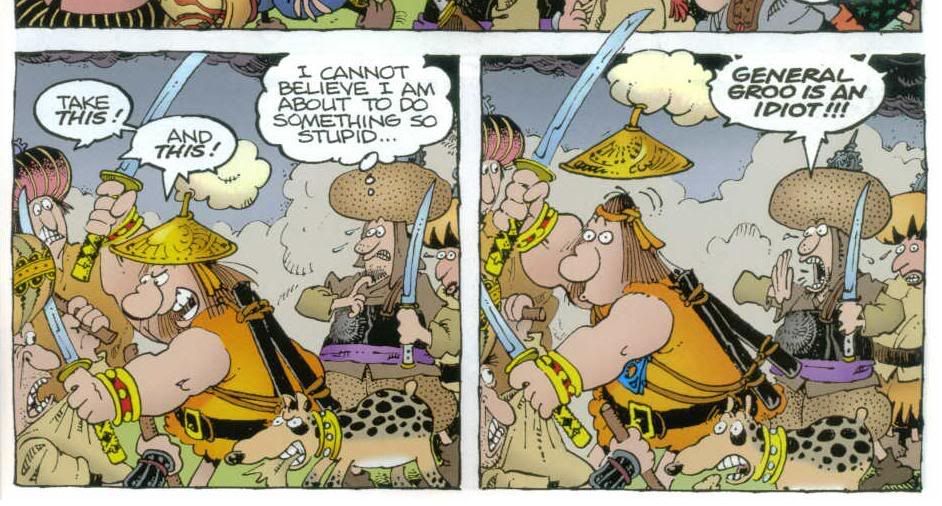First up this week is Detective Comics #843 (written by Paul Dini, pencilled by Dustin Nguyen, inked by Derek Fridolfs), an issue which mixes the Penguin, Zatanna, the Ventriloquist, and a couple of characters from earlier in Dini's tenure. With all of those players, you'd think there's not much room for Batman, and indeed, Bruce Wayne is in it more than Batman is. It's a tightly-plotted issue revolving around a Gotham rich-kid opening a nightclub to compete with the Penguin's, and hiring Zatanna for a little extra sizzle. The Ventriloquist's new "voice" reveals a surprising secret, and the cliffhanger's pretty good too. As for the art, I don't dislike Nguyen and Fridoffs, but I'm still getting used to their style. Nguyen uses very thin lines and Fridoffs is heavy on the blacks, and it reminds me of early Mike Mignola.
Keeping with the Bat-theme, here's Nightwing #143 (written by Peter Tomasi, pencilled by Don Kramer, inked by Christian Alamy and Mark McKenna), a stopping point in the current grave-robbing-villain storyline. If you like Nightwing and Robin vs. an island base full of zombie super-soldiers, scenes punctuated by witty banter, and references to classic rock and Jaws, this is the issue for you. I found it to be a little too pleased with itself, but still an improvement for the title overall. Don Kramer fills in for Rags Morales this issue, but except for a little more stiffness I didn't really notice. Together with Alamy and McKenna, the art isn't too far from normal.
The fill-in work of Ron Randall is less noticeable on Supergirl #28 (written by Kelley Puckett, with the balance pencilled by Drew Johnson and inked by Ray Snyder), an issue that was actually pretty decent. After more than a few issues so inscrutable they'd make the average episode of "Aeon Flux" look like a flowchart, here's one which starts to pull everything together. Supergirl has promised an adorable moppet she'll find a cure for his cancer. Naturally, everyone (personified here initially by Wonder Woman) thinks she's nuts. Supergirl then finds a cult-favorite DC character from the '90s (I won't spoil the cover's tease!) to try and convert to her side. Most of the issue involves Supergirl talking to Wonder Woman and then to Mystery Character, and she does continue to act a bit weird, but with this issue I felt like there was a purpose.
Sadly, that provides an apt segue into Countdown #4 (written by Paul Dini and Sean McKeever, story consultant Keith Giffen, pencilled by Jamal Igle, inked by Keith Champagne), which once again seems to have lost sight of its purpose. After the last few weeks' detour with the Great Disaster, our heroes are back on the real Earth ... but, as the cover indicates, Mary Marvel has decided to go back to the black-cheerleader outfit which got her in so much trouble 30 years ago when this series was still young. So she fights the Atom and Green Lantern and Troia on the steps of the Hall of Justice (the JLA's not home, of course) in order to kidnap Jimmy Olsen for Darkseid. I like Jamal Igle and Keith Champagne's work a lot, although their Darkseid seemed a little off, so I didn't have many complaints with the art. I guess the overall story is starting to come together too. However, the Mary Marvel "reversion" still feels like a sharp yank after all that buildup to "redeem" her.
Finally -- and I do mean finally! -- Action Comics #863 (written by Geoff Johns, pencilled by Gary Frank, inked by Jon Sibal) provides the big blowout conclusion to "Superman and the Legion of Super-Heroes." The payoff is Superman (and, eventually, the Legion)'s fight with Earth-Man in the streets of Metropolis. The secondary payoffs are a couple of rah-rah spreads of the Legion. Sun Boy's role in the story seemed a little too convenient, but considering that this arc could easily have lost an issue without much trouble, I appreciated this installment's pacing. Also, remember last time how I didn't like the way Butch Guice "directed" Cap's fall onto the hovercar? This issue features Superman falling pretty much from orbit, to entirely predictable results, but I liked the way Frank laid out the sequence. Frank's faces are still a bit creepy (those eyes!) and everyone looks kinda pale (thanks to Dave McCaig), but on the whole I can't complain.
Full Post


![]()
![]()


![]()
![]()
![]()
![]()

![]()
![]()

![]()

![]()

![]()
![]()